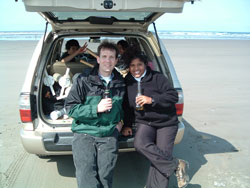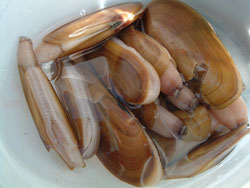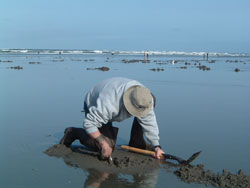|
We went
razor clamming in the spring of 2004 with Mei and Brian and their
kids. It was our first time clamming, so we bought
 clam
tubes, licenses, and beer and headed up to Ocean Shores,
Washington, where the hordes were out for the last day of
clamming season. The clam tubes were very easy to use, and
I got my 15-clam limit within the first twenty minutes. We
then spent the rest of two hours trying to find Sandra her 15.
It was a good time doing the digging, but we found out that it
took hours to clean all the clams we got! We didn't care
for the taste of the razor clams that much, so it definitely
wasn't worth the work! After clamming, we met Craig,
Denise, Dan, Mary, Ken, and Jeannette in Naselle and feasted on
Salmon and Clams. It was a good trip, and a unique
experience. At the bottom of the page you'll see our
photos. clam
tubes, licenses, and beer and headed up to Ocean Shores,
Washington, where the hordes were out for the last day of
clamming season. The clam tubes were very easy to use, and
I got my 15-clam limit within the first twenty minutes. We
then spent the rest of two hours trying to find Sandra her 15.
It was a good time doing the digging, but we found out that it
took hours to clean all the clams we got! We didn't care
for the taste of the razor clams that much, so it definitely
wasn't worth the work! After clamming, we met Craig,
Denise, Dan, Mary, Ken, and Jeannette in Naselle and feasted on
Salmon and Clams. It was a good trip, and a unique
experience. At the bottom of the page you'll see our
photos.
The
Pacific razor clam (Siliqua patula) is an exceptionally
meaty shellfish which ranges from California to Alaska. It is
abundant on surf-pounded ocean beaches, but also occurs in
sheltered areas along the coast. Limited diving observations
have indicated some adult razor clams (S.patula)
offshore for up to one-half mile. Razor clams dredged in water
deeper than 30 feet, although similar to the beach clam, are a
different species (Siliqua sloati).
In
Washington waters, the razor clam grows to a maximum length of
six inches, although they are seldom found. Clams seven inches
long have been recorded, but are very rare. The life expectancy for Washington clams is five years. Again, there
are exceptions, but razor clams suffer from a high degree of
mortality due to predation by Dungeness crabs, shore birds,
numerous species of fish and of course thousands of clam
diggers. A disease was also discovered in the early 1980's that
caused mass mortalities of large numbers of clams. It is unknown
how long this disease has affected clam populations. In
contrast, razor clams found in Alaska may grow to eleven inches
in length and live to be 15 years old, due to colder water
temperatures and slower growth rates.
life expectancy for Washington clams is five years. Again, there
are exceptions, but razor clams suffer from a high degree of
mortality due to predation by Dungeness crabs, shore birds,
numerous species of fish and of course thousands of clam
diggers. A disease was also discovered in the early 1980's that
caused mass mortalities of large numbers of clams. It is unknown
how long this disease has affected clam populations. In
contrast, razor clams found in Alaska may grow to eleven inches
in length and live to be 15 years old, due to colder water
temperatures and slower growth rates.
Razor
clams are found primarily on the intertidal coastal beaches
(those that are exposed at low tide) from a +3 foot level to a
-2 foot tide level. The Washington Department of Fish and
Wildlife (WDFW) divides the harvest areas into five major
management zones (see map):
- Long Beach
from the Columbia River north to the mouth of the Willapa Bay
- Twin Harbors
from Willapa Bay north to the south jetty at the mouth of
Grays Harbor
- Copalis
Beach from the north jetty at the mouth of Grays
Harbor to the Copalis River
- Mocrocks
from the Copalis River to the south boundary of the Quinault
Indian Reservation and
- Kalaloch
from the South Beach campground north to ONP Beach Trail 3.
Other
areas where razor clams exist are: a series of sand spits in the
mouth of Willapa Bay, the Quinault Indian Reservation and
numerous small beaches north of Olympic National Park (ONP)
Trail 3 at Kalaloch. The sand spits in Willapa Bay are referred
to as the Willapa Spits and are used for commercial harvest.
The
first fifteen razor clams regardless of size or condition must
be retained. One daily limit of fresh shellfish may be in
possession. Additional
 shellfish
may be possessed in a frozen or processed form. Razor clams may
not be returned to the beach. For razor clams, holes do not
have to be refilled as is required for hardshell clam digging.
Razor clams may be taken by hand,
hand-operated shovel, or
tube with a minimum outside diameter of 4" or (4" x 3" if
elliptical). Each digger must use a separate container, but may
share digging equipment. Razor clams are strictly managed
by determining clam population levels and harvest plans are set
every year. Contact the WDFW
Coastal Washington
regional office for details on upcoming seasons. shellfish
may be possessed in a frozen or processed form. Razor clams may
not be returned to the beach. For razor clams, holes do not
have to be refilled as is required for hardshell clam digging.
Razor clams may be taken by hand,
hand-operated shovel, or
tube with a minimum outside diameter of 4" or (4" x 3" if
elliptical). Each digger must use a separate container, but may
share digging equipment. Razor clams are strictly managed
by determining clam population levels and harvest plans are set
every year. Contact the WDFW
Coastal Washington
regional office for details on upcoming seasons.
-
http://wdfw.wa.gov/fish/shelfish/razorclm/razorclm.htm
Clamming
Links
|